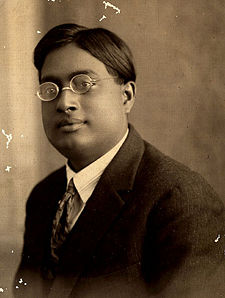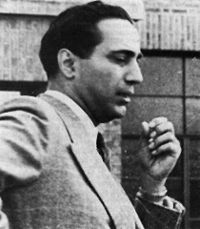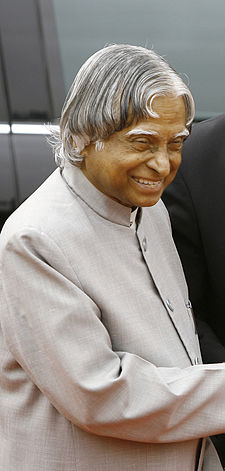Satyendra Nath Bose
Born January 1, 1894(1894-01-01)
Calcutta, IndiaDied February 4, 1974 (aged 80)
Calcutta, IndiaResidence India Nationality Indian Fields Physics Institutions University of Calcutta
University of DhakaAlma mater Presidency College of the University of Calcutta Doctoral advisor Sahill Poddar Known for Bose–Einstein condensate, Bose–Einstein statistics, Bose gas
Note that Bose did not have a doctorate, but obtained an MSc from the University of Calcutta in 1915 and therefore did not have a doctoral advisor. However his equivalent mentor was J. C. Bose.He was a Bengali physicist, specializing in mathematical physics. He is best known for his work on quantum mechanics in the early 1920s, providing the foundation for Bose-Einstein statistics and the theory of the Bose-Einstein condensate. He is honored as the namesake of the boson.
Although more than one Nobel Prize was awarded for research related to the concepts of the boson, Bose-Einstein statistics and Bose-Einstein condensate—the latest being the 2001 Nobel Prize in Physics, which was given for advancing the theory of Bose-Einstein condensates, Bose himself was never awarded the Nobel Prize in Physics. Among his other talents, Bose spoke several languages and could also play the Esraj, a musical instrument similar to a violin.Early life and career
Bose was born in Kolkata (Calcutta), India, the eldest of seven children. His father, Surendranath Bose, worked in the Engineering Department of the East India Railway.
Bose attended Hindu School in Calcutta, and later attended Presidency College, also in Calcutta, earning the highest marks at each institution. He came in contact with teachers such as Jagadish Chandra Bose (no relation) and Prafulla Chandra Roy who provided inspiration to aim high in life. From 1916 to 1921 he was a lecturer in the physics department of the University of Calcutta. In 1921, he joined the department of Physics of the then recently founded Dacca University (now in Bangladesh and called University of Dhaka), again as a lecturer.
In 1924 Bose wrote a paper deriving Planck's quantum radiation law without any reference to classical physics. After initial setbacks to his efforts to publish, he sent the article directly to Albert Einstein in Germany. Einstein, recognizing the importance of the paper, translated it into German himself and submitted it on Bose's behalf to the prestigious Zeitschrift für Physik. As a result of this recognition, Bose was able to leave India for the first time and spent two years in Europe, during which he worked with Louis de Broglie, Marie Curie, and Einstein.
Bose returned to Dhaka in 1926. He became a professor and was made head of the Department of Physics, and continued teaching at Dhaka University until 1945. At that time he returned to Calcutta, and taught at Calcutta University until 1956, when he retired and was made professor emeritus.Anecdote
Once the great scientist, Niels Bohr, was delivering a lecture. Bose presided. At one stage the lecturer had some difficulty in explaining a point. He had been writing on the blackboard; he stopped and, turning to Bose, said, "Can Professor Bose help me?" All the while Satyendranath had been sitting with his eyes shut. The audience could not help smiling at Professor Bohr's words. But to their great surprise, Bose opened his eyes; in an instant he solved the lecturer's difficulty. Then he sat down and once again closed his eyes![3]
Homi J. Bhabha
Homi Jehangir Bhabha (1909-1966)
Born
30 October 1909
Bombay, IndiaDied
24 January 1966 (aged 56)
Mont Blanc, FranceResidence
India
Nationality
Indian
Ethnicity
Parsi (Guebre)
Fields
Physicist
Institutions
Cavendish Laboratories
Tata Institute of Fundamental Research
Atomic Energy Commission of IndiaAlma mater
University of Cambridge
Doctoral advisor
Paul Dirac
Ralph H. FowlerDoctoral students
B. V. Sreekantan
Known for
Bhabha scattering
Religious stance
Zoroastrianism
Homi Jehangir Bhabha, FRS (October 30, 1909 – January 24, 1966) was an Indian nuclear physicist who had a major role in the development of the Indian atomic energy program and is considered to be the father of India's nuclear program. Bhabha was born into a prominent family, through which he was related to Dinshaw Maneckji Petit, Muhammad Ali Jinnah, Homi K Bhabha and Dorab Tata. After receiving his early education at Bombay schools and at the Royal Institute of Science, he attended Caius College of Cambridge University to pursue studies in mechanical engineering. After taking the mechanical engineering Tripos, he pursued studies under Paul Dirac to complete the Mathematics Tripos. Meanwhile, he worked at the Cavendish Laboratory while working towards his doctorate in theoretical physics under R. H. Fowler. During this time, he embarked on groundbreaking research into the absorption of cosmic rays and electron shower production. Afterwards, he published a string of widely-accepted papers on his theories regarding cosmic ray showers.
Chandrasekhara Venkata Raman
Born November 7, 1888(1888-11-07)
Tiruchirapalli, Madras Presidency, IndiaDied November 21, 1970 (aged 82)
Bangalore, Karnataka, India
Nationality Indian Fields Physics Institutions Indian Finance Department
Indian Association for the Cultivation of Science
Indian Institute of ScienceAlma mater Presidency College Doctoral students G. N. Ramachandran Known for Raman effect Notable awards Nobel Prize in Physics (1930)
Bharat Ratna
Lenin Peace PrizeReligious stance Hindu Bharat Ratna Sir Chandrasekhara Venkata Raman, FRS (Tamil:) (7 November 1888 – 21 November 1970) was an Indian physicist who was awarded the 1930 Nobel Prize in Physics for his work on the molecular scattering of light and for the discovery of the Raman effect, which is named after him.
BiographyEarly years
Chandrasekhara Venkata Raman was born on November 7, 1888, in an Iyer family in Tiruchirapalli, Tamil Nadu. At an early age Raman moved to the city of Visakhapatnam, Andhra Pradesh. His father was a lecturer in mathematics and physics, so he grew up in an academic atmosphere. His nephew Subramanyan Chandrasekhar also won a Nobel prize in physics in 1983.
Middle years
Raman entered Presidency College, Madras, in 1902, and in 1904 gained his BA, winning the first place and the gold medal in physics. In 1907 he gained his MA, obtaining the highest distinctions. He joined the Indian Finance Department as an Assistant Accountant General in Calcutta. As the story goes, one evening while returning from work, he spotted the sign of the Indian Association for the Cultivation of Science (IACS). He started visiting the laboratory after office hours and did experiments, which culminated with his Nobel Prize winning work.[citation needed]
In 1917 Raman resigned from his government service and took up the newly created Palit Professorship in Physics at the University of Calcutta. Simultaneously, he continued doing research at the IACS, where he became the Honorary Secretary. Raman used to refer to this period as the golden era of his career. Many talented students gathered around him at the IACS and the University of Calcutta. He was president of the 16th session of the Indian Science Congress in 1929.
Raman won the 1930 Nobel Prize in Physics for his work on the scattering of light and for the discovery of the Raman effect. Raman spectroscopy is based on this phenomenon. He was the first Asian and first non-White to get any Nobel Prize in Science. Before him Sir Rabindranath Tagore (also Indian) had received Nobel Prize for Literature.
Raman also worked on the acoustics of musical instruments. He worked out the theory of transverse vibration of bowed strings, on the basis of superposition velocities. He was also the first to investigate the harmonic nature of the sound of the Indian drums such as the tabla and the mridangam.
In 1934 Raman became the director of the Indian Institute of Science in Bangalore, where two years later he continued as a professor of physics. Other investigations carried out by Raman were: his experimental and theoretical studies on the diffraction of light by acoustic waves of ultrasonic and hypersonic frequencies (published 1934-1942), and those on the effects produced by X-rays on infrared vibrations in crystals exposed to ordinary light.
He also started a company called Travancore Chemical and Manufacturing Co. Ltd. in 1943 along with Dr. Krishnamurthy. The Company during its 60 year history, established 4 factories in Southern India. In 1947, he was appointed as the first National Professor by the new government of Independent India.
In 1948 Raman, through studying the spectroscopic behavior of crystals, approached in a new manner fundamental problems of crystal dynamics. He dealt with the structure and properties of diamond, the structure and optical behavior of numerous iridescent substances (labradorite, pearly felspar, agate, opal, and pearls). Among his other interests were the optics of colloids, electrical and magnetic anisotropy, and the physiology of human vision.
11th President of IndiaIn office
July 25, 2002 – July 25, 2007Vice President Bhairon Singh Shekhawat Preceded by K. R. Narayanan Succeeded by Pratibha Patil
Born October 15, 1931 (1931-10-15) (age 76)[1]
Dhanushkodi, Rameswaram, Madras Presidency,Political party Not affiliated Spouse Single; Never married Religion Islam Abul Pakir Jainulabdeen Abdul Kalam Tamil: born October 15, 1931, Tamil Nadu, India, usually referred as Dr. A. P. J. Abdul Kalam^ , was the eleventh President of India, serving from 2002 to 2007.[2] Due to his unconventional working style, he is also popularly known as the People's President. Before his term as India's president, he distinguished himself as engineering visionary and was awarded India's highest civilian honour Bharat Ratna in 1997 for his work with DRDO and his role as scientific advisor to the Indian government. He is popularly known as the Missile Man of India for his work and is considered a progressive mentor, innovator and visionary in India.
Honours
He has received honorary doctorates from as many as thirty universities .[3] The Government of India has honoured him with the nation's highest civilian honours: the Padma Bhushan in 1981; Padma Vibhushan in 1990; and the Bharat Ratna in 1997.
Kalam is the Fourth President of India to have been honoured with a Bharat Ratna before being elected to the highest office, the other three being Sarvepalli Radhakrishnan ,V. V. Giri and Zakir Hussain. He is also the first scientist and first bachelor to occupy Rashtrapati Bhavan.
Referred to as the "People's President", Kalam is often considered amongst India's greatest presidents, going on to win a poll conducted by news channel CNN-IBN for India's Best President.
Political viewsKalam's probable views on certain issues have been espoused by him in his book India 2020 where he strongly advocates an action plan to develop India into a knowledge superpower and into a developed nation by the year 2020. Kalam is credited with the view that India ought to take a more assertive stance in international relations; he regards his work on India's nuclear weapons program as a way to assert India's place as a future superpower.
Kalam continues to take an active interest in other developments in the field of science and technology as well. He has proposed a research programme for developing bio-implants. He is a supporter of Open source software over proprietary solutions and believes that the use of open source software on a large scale will bring more people the benefits of information technology.
Kalam's belief in the power of science to resolve society's problems and his views of these problems as a result of inefficient distribution of resources is modernistic. He also sees science and technology as ideology-free areas and emphasizes the cultivation of scientific temper and entrepreneurial drive. In this, he finds a lot of support among India's new business leaders like the founders of Infosys and Wipro, (leading Indian IT corporations) who began their careers as technology professionals much in the same way Kalam did.
His views on issues of peace and weapons seem to be contradictory. On close examination of his thoughts it looks practical. He is quoted as follows
In the 3,000-year history of India, barring 600 years, the country has been ruled by others. If you need development, the country should witness peace and peace is ensured by strength. Missiles were developed to strengthen the country.
Personal life
APJ Abdul Kalam was born in 1931 in a middle-class family in Rameshwaram, Tamil Nadu, a town well-known for its Hindu shrines. His mother tongue is Tamil. His father, a devout Muslim, owned boats which he rented out to local fishermen and was a good friend of Hindu religious leaders and the school teachers at Rameshwaram. APJ Abdul Kalam mentions in his biography that to support his studies, he started his career as a newspaper vendor. This was also told in the book, A Boy and His Dream: Three Stories from the Childhood of Abdul Kalam by Vinita Krishna. The house Kalam was born in can still be found on the Mosque street at Rameswaram, and his brother's curio shop abuts it. This has become a point-of-call for tourists who seek out the place. Kalam grew up in an intimate relationship with nature, and he says in Wings of Fire that he never could imagine that water could be so powerful a destroying force as that he witnessed when he was six. That was in 1934 when a cyclonic storm swept away the Pamban bridge and a trainload of passengers with it and also Kalam's native village, Dhanushkodi.
Kalam observes strict personal discipline, vegetarianism, teetotalism and celibacy. Kalam is a scholar of Thirukkural; in most of his speeches, he quotes at least one kural. Kalam has written several inspirational books, most notably his autobiography Wings of Fire, aimed at motivating Indian youth. Another of his books, Guiding Souls: Dialogues on the Purpose of Life reveals his spiritual side. He has written poems in Tamil as well. It has been reported that there is considerable demand in South Korea for translated versions of books authored by him.
Dr. Kalam received an honorary doctorate from Carnegie Mellon University.
Kalam as an engineer
Abdul Kalam graduated from Madras Institute of Technology majoring in Aeronautical Engineering. As the Project Director, he made significant contributions to the development of India's first indigenous Satellite Launch Vehicle (SLV-III). As Chief Executive of Integrated Guided Missile Development Programme (IGMDP), he also played major part in developing many missiles of India including Agni and Prithvi. He was the Chief Scientific Adviser to Defence Minister and Secretary, Department of Defence Research & Development from July 1992 to December 1999. Pokhran-II nuclear tests were conducted during this period, led by him.




